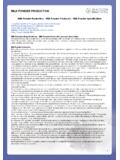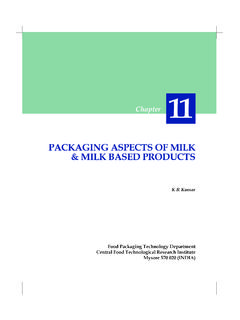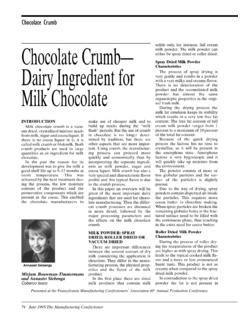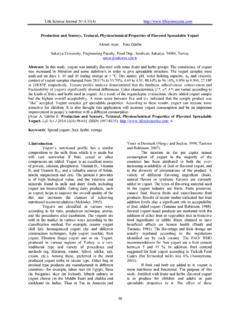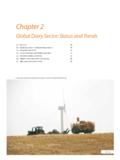Transcription of DAIRY AND DAIRY PRODUCTS - Food and Agriculture ...
1 3. COMMODITY SNAPSHOTSOECD-FAO AGRICULTURAL OUTLOOK 2016-2025 OECD/FAO 2016110 DAIRY AND DAIRY PRODUCTSM arket situationInternational prices of all DAIRY PRODUCTS continued to decline from their 2013 peak, inparticular for skim milk powder (SMP) and whole milk powder (WMP). A key factor was thedecline in Chinese import demand, with demand for WMP dropping by 34% from 2014levels. This decrease in Chinese demand for DAIRY PRODUCTS was coupled with continuedproduction growth between 2014 and 2015, in key export markets, with total output ofmilk increasing in Australia (4%), the European Union (2%), New Zealand (5%) andthe United States (1%).The Russian Federation s ban on imports continues to restrict DAIRY trade.
2 Russiancheese imports dropped by 62% between 2013 and 2015, which mainly affected exportsfrom the European Union, the United States and Australia. Conversely, Belarus has greatlyincreased cheese exports to the Russian Federation, supplementing demand there. Theban is assumed to continue until the start of 2017; with imports of cheese expected toincrease sharply as trading resumes, mostly supplied from the European Union andthe United States, albeit at lower levels than prior to the in Oceania is facing challenges, low DAIRY prices have caused a reduction inthe total DAIRY herd, which dropped by in 2015. Furthermore drought and adverseweather conditions related to a very strongEl Ni ohave restricted production in Oceania spasture-based systems in 2016; this is expected to reduce production in New Zealand and to stall growth in good margins combined with the removal of the EU milk quota as ofApril 2015 has promoted growth in total milk production in the European Union.
3 Thisgrowth, however, has been uneven across member states. For example, milk deliveriesfrom the 2014 to 2015 marketing year (April-March) increased by in Ireland, inGermany, in the United Kingdom, and in the Netherlands. With increased milkproduction and limited growth in domestic consumption, EU exports for all major dairycommodities on aggregate are expected to increase by between the 2013-15 baseyears and highlightsPer capita demand for DAIRY PRODUCTS in developing countries is expected to growconsistently over the medium-term, supported by rising incomes and lower DAIRY pricesrelative to their 2013 peak. As seen in previous years there is a continued shift in dietarypatterns away from staples and towards animal PRODUCTS , due to changes in diets.
4 Strongconsumptiongrowthisexpectedacrosss everalmarketsintheMiddleEastandAsia,incl uding Saudi Arabia, Egypt, Iran and Indonesia, with the per capita consumption ofdairy PRODUCTS in developing countries growing between and , the lowestgrowth being for cheese and the highest for fresh DAIRY PRODUCTS . In addition, per capitaconsumption in the developed world is expected to grow between for fresh dairyproducts and for COMMODITY SNAPSHOTSOECD-FAO AGRICULTURAL OUTLOOK 2016-2025 OECD/FAO 2016111 World milk production is projected to increase by 177 Mt (23%) by 2025 compared tothe base years (2013-15), corresponding to an average grow rate of which is belowthe witnessed in the last decade. The majority of this growth (73%) is anticipatedto come from developing countries, in particular India and Pakistan.
5 This expansion ofproduction is largely in fresh DAIRY PRODUCTS , which will grow at in developingcountries, and predominantly supply domestic markets. At the world level, production ofthe main DAIRY PRODUCTS (butter, cheese, SMP and WMP) is increasing at similar pace to milkproduction, albeit more slowly than that of fresh DAIRY a result of these demand and supply factors, nominal prices of all DAIRY productsare expected to increase over the medium-term, along with real prices of milk powders,which recover from their current lows. The real prices of butter and cheese are expected todecline slightly over the next decade, although this is from a comparatively higher baselevel than for milk strengthening of both the US Dollar and the euro will put pressure on the growthof exports from the United States and the European Union, as they become lesscompetitive on the global market.
6 Conversely, exporters in Argentina, Australia andNew Zealand are projected to become more competitive on the world market due torelatively weaker export growth is expected over the coming decade following the slumpin 2014-15. Butter, cheese, SMP and whey all average strong growth of over 2%. Growth forexports of WMP is more modest at With low DAIRY prices serving as a barrier tomarket entry for non-traditional exporters, export growth will continue to be satisfied by asmall concentration of key exporters. The European Union will be the principle exporter ofSMP and cheese, and New Zealand the lead exporter of butter and WMP, as shown inFigure of DAIRY PRODUCTS by regionSource:OECD/FAO (2016), OECD-FAO Agricultural Outlook ,OECD Agriculture statistics(database), 2 milk powderWhole milk powderMtRest of the WorldArgentinaAustraliaEuropean UnionNew ZealandUnited States3.
7 COMMODITY SNAPSHOTSOECD-FAO AGRICULTURAL OUTLOOK 2016-2025 OECD/FAO 2016112 The global DAIRY commodity market is prone to disturbances from weather variability,changes in policy, and the opening or closing of trade in key countries. Many of thedevelopments in the DAIRY market will stem from import demand in the China and howquickly producers react to lower prices. TheOutlookforesees a strengthening of demandfrom developing countries and assumes that while China does not resume importing WMPand butter at 2014 levels, instead servicing much of its demand internally, SMP and cheeseimports will increase over the outlook expanded DAIRY and DAIRY PRODUCTS chapter is available AND DAIRY PRODUCTS 1 OECD-FAO AGRICULTURAL OUTLOOK 2016 OECD/FAO 2016 DAIRY AND DAIRY PRODUCTS Prices Product prices of milk and DAIRY PRODUCTS declined sharply in 2014-15 due to decreased global demand and increased global production.
8 Global demand for processed DAIRY PRODUCTS has dropped as the People s Republic of China (hereafter China ) has decreased its import demand, largely for whole milk powder (WMP) and skim milk powder (SMP), and the Russian Federation s import embargo for several DAIRY PRODUCTS from major exporting countries continues. On the supply side, increases in production from key exporters have also placed downward pressure on world prices as low input prices have fuelled additional production in the United States and recent good margins, as well as the removal of milk quotas, has allowed for production growth in the European Union. Over the medium term, demand for milk and DAIRY PRODUCTS in developing countries is expected to rise as a result of increasing incomes, growing population, and changing diets.
9 While most of this growth will be satisfied by domestic production via increasing DAIRY herds and rising yields, additional import demand will support world prices of DAIRY PRODUCTS during the next decade (Figure ). Cheese prices in nominal terms are expected to maintain a considerable premium over the other DAIRY PRODUCTS , due to the strong demand increase compared with other DAIRY PRODUCTS in both developing and (especially) developed countries. Nominal prices are not expected to reach the highs of the last few years. Figure DAIRY product prices Note: Butter, Skim Milk Powder, export price, non-fat dry milk, butterfat, Oceania; Whole Milk Powder, export price, 26% butterfat, Oceania; Cheese, , export price, cheddar cheese, 39% moisture, Oceania.
10 Real prices are nominal world prices deflated by the US GDP deflator (2010=1). Source: OECD/FAO (2016), OECD-FAO Agricultural Outlook , OECD Agriculture statistics (database), 12 01 0002 0003 0004 0005 0006 0001995200020052010201520202025199520002 0052010201520202025199520002005201020152 02020251995200020052010201520202025 ButterCheeseSkim milk powderWhole milk powderUSD/tNominal priceReal price2 DAIRY AND DAIRY PRODUCTS OECD-FAO AGRICULTURAL OUTLOOK 2016 OECD/FAO 2016 Over the next ten years, it is expected that real DAIRY product prices will increase slightly. Nevertheless, real prices will remain below average prices of recent years, but substantially higher than in the period before 2007.










